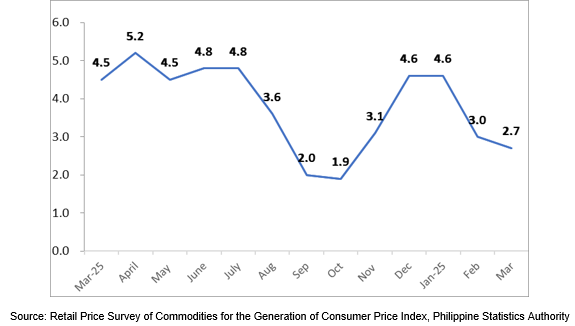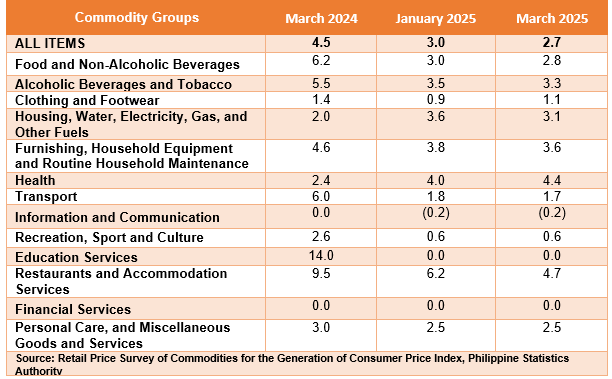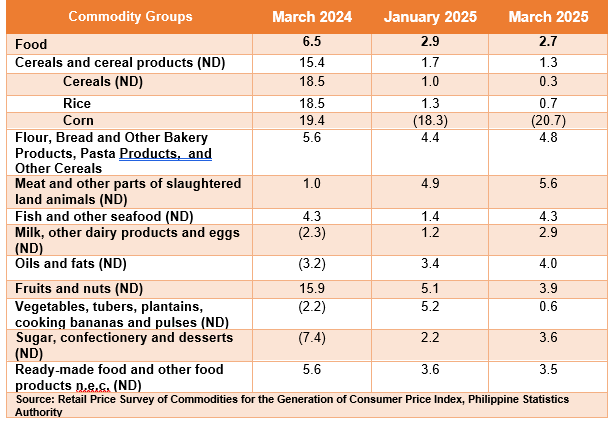Table A. Year-on-Year Inflation Rates, All Items
In percent
(2018=100)

Figure 1. Headline Inflation Rates in Baguio City, All Items
(2018=100)

Table B. Year-on-Year Inflation in Baguio City, By Commodity Groups
In percent
(2018=100)

Table C. Year-on-Year Food Inflation in Baguio City
In percent
(2018=100)

Baguio City
Headline Inflation
The headline inflation or overall inflation of the city for the bottom 30% income household further decreased to 2.7 percent in March 2025 from 3.0% in the previous month. In March 2024, the inflation rate was 4.5 percent. (Figure 1, and Tables A and B)
The top 3 main driver to the downtrend were the following:
a. Housing, water, electricity, gas and other fuels, 3.1 percent from 3.6 percent;
b. Food and Non-alcoholic beverages, 2.8 percent from 3.0 percent; and
c. Restaurant and accommodation services, 4.7 percent from 6.2 percent.
Lower annual increments were also noted on the following:
a. Alcoholic beverages and tobacco, 3.3 percent from 3.5 percent;
b. Furnishings, household equipment and routine household maintenance, 3.6 percent from 3.8 percent; and
c. Transport, 1.7 percent from 1.8 percent.
On the contrary, the index of clothing and footwear, and health services exhibited higher annual increases during the month with 1.1 percent and 4.4 percent, respectively.
The indices of the rest of the commodity groups retained their respective previous month’s annual rates.
Main Contributors to the Headline Inflation
The top three commodity groups contributing to the March 2025 overall inflation were the following:
a. Food and non-alcoholic beverages;
b. Housing, water, electricity, gas and other fuels; and
c. Personal care, and miscellaneous goods and services.
Food Inflation
Food inflation at the city for the bottom 30% income household decreased to 2.7 percent in March 2025 from 2.9 percent in the previous month. In March 2024, food inflation was at 6.5 percent. (Table C)
Main Drivers to the Downward Trend of Food Inflation
The deceleration of food inflation in March 2025 was primarily brought about by vegetables, tubers, plantains, cooking bananas and pulses with 0.6 percent from 5.2 percent in the previous month. This was followed by cereal and cereal products, particularly rice with 0.7 percent and 1.3 percent, and fruits and nuts with 3.9 percent from 5.1 percent.
Ready-made food and other food products also had lower inflation rates with 3.5% from 3.6%.
In contrast, higher inflation rates were noted on rest of the food groups.
Main Contributors to the Food Inflation
The top three food groups in terms of contribution to the food inflation during the month were the following:
a. Meat and other parts of slaughtered land animals;
b. Fish and other seafood; and
c. Cereals and cereal products,
Note: CPIs and inflation rates by region, province and selected city are posted at the PSA website (https://openstat.psa.gov.ph/).
IMELDA L. BUYUCCAN (SGD)
Chief Statistical Specialist
/SMBP

